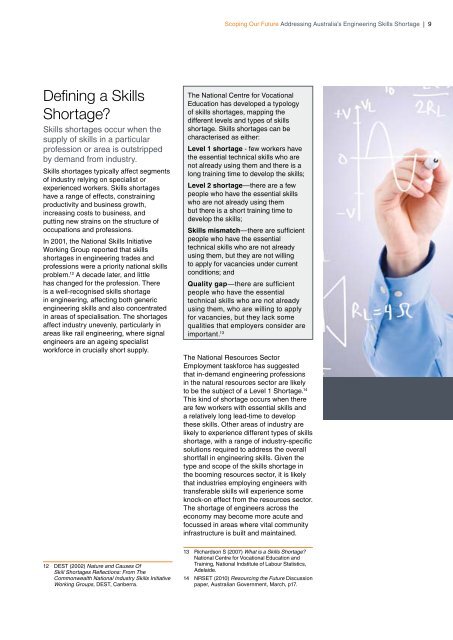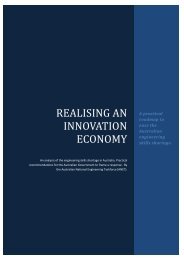scoping our future - ANET - Australian National Engineering Taskforce
scoping our future - ANET - Australian National Engineering Taskforce
scoping our future - ANET - Australian National Engineering Taskforce
You also want an ePaper? Increase the reach of your titles
YUMPU automatically turns print PDFs into web optimized ePapers that Google loves.
Scoping Our Future Addressing Australia’s <strong>Engineering</strong> Skills Shortage | 9Defining a SkillsShortage?Skills shortages occur when thesupply of skills in a particularprofession or area is outstrippedby demand from industry.Skills shortages typically affect segmentsof industry relying on specialist orexperienced workers. Skills shortageshave a range of effects, constrainingproductivity and business growth,increasing costs to business, andputting new strains on the structure ofoccupations and professions.In 2001, the <strong>National</strong> Skills InitiativeWorking Group reported that skillsshortages in engineering trades andprofessions were a priority national skillsproblem. 12 A decade later, and littlehas changed for the profession. Thereis a well-recognised skills shortagein engineering, affecting both genericengineering skills and also concentratedin areas of specialisation. The shortagesaffect industry unevenly, particularly inareas like rail engineering, where signalengineers are an ageing specialistworkforce in crucially short supply.The <strong>National</strong> Centre for VocationalEducation has developed a typologyof skills shortages, mapping thedifferent levels and types of skillsshortage. Skills shortages can becharacterised as either:Level 1 shortage - few workers havethe essential technical skills who arenot already using them and there is along training time to develop the skills;Level 2 shortage—there are a fewpeople who have the essential skillswho are not already using thembut there is a short training time todevelop the skills;Skills mismatch—there are sufficientpeople who have the essentialtechnical skills who are not alreadyusing them, but they are not willingto apply for vacancies under currentconditions; andQuality gap—there are sufficientpeople who have the essentialtechnical skills who are not alreadyusing them, who are willing to applyfor vacancies, but they lack somequalities that employers consider areimportant. 13The <strong>National</strong> Res<strong>our</strong>ces SectorEmployment taskforce has suggestedthat in-demand engineering professionsin the natural res<strong>our</strong>ces sector are likelyto be the subject of a Level 1 Shortage. 14This kind of shortage occurs when thereare few workers with essential skills anda relatively long lead-time to developthese skills. Other areas of industry arelikely to experience different types of skillsshortage, with a range of industry-specificsolutions required to address the overallshortfall in engineering skills. Given thetype and scope of the skills shortage inthe booming res<strong>our</strong>ces sector, it is likelythat industries employing engineers withtransferable skills will experience someknock-on effect from the res<strong>our</strong>ces sector.The shortage of engineers across theeconomy may become more acute andfocussed in areas where vital communityinfrastructure is built and maintained.12 DEST (2002) Nature and Causes OfSkill Shortages Reflections: From TheCommonwealth <strong>National</strong> Industry Skills InitiativeWorking Groups, DEST, Canberra.13 Richardson S (2007) What is a Skills Shortage?<strong>National</strong> Centre for Vocational Education andTraining, <strong>National</strong> Indstitute of Lab<strong>our</strong> Statistics,Adelaide.14 NRSET (2010) Res<strong>our</strong>cing the Future Discussionpaper, <strong>Australian</strong> Government, March, p17.




